Today there is a dominance of technology in our lives. We are so accustomed to using technical devices and gadgets that if we don’t have the right device at hand, we become uncomfortable. Remember how you felt when you forgot your phone at home? You start to get nervous, worry, and constantly think about how many calls you missed. This is just a small example of dependence on a technical device from a huge number of them. At school, every person learns the multiplication table, then comprehends the basics of multiplication in a column on paper. The smartest and most capable can count in their heads, multiplying multi-digit numbers. But honestly, who can now multiply two hundred and forty-one by one hundred and twenty-five?
Most of us will use a pocket calculator or other electronic gadget. The availability of technology relaxes our brain, and getting it to move is a big problem for most ordinary people. But I don’t want to read notations here (it’s easier for me to pick up a calculator), but I want to share with you an interesting method of quick multiplication multi-digit numbers on paper without using a calculator.
For this we only need a piece of paper and a pen. But don’t think that now I will show you ordinary multiplication in a column. Everything is much more interesting. So let's get started. Let's multiply the previously announced numbers: 241 * 125 = ?
On paper we begin to draw horizontal lines according to the numbers of the first number. The first digit on the left of 214 is two. Draw two parallel horizontal lines.

Next, just below, draw horizontal lines in an amount equal to the second number from the left - one line.
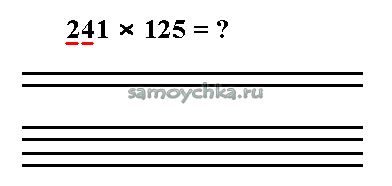
Then we draw lines even lower for the third number. 
Now let's move on to the second number. For it we draw vertical lines according to the same principle as for the first number.
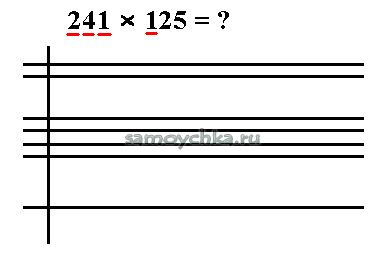

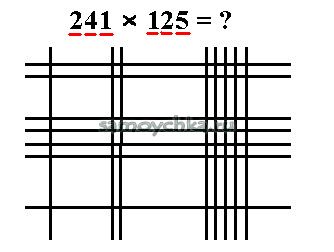
 We count the number of intersections in each of the resulting sectors and write them down.
We count the number of intersections in each of the resulting sectors and write them down.

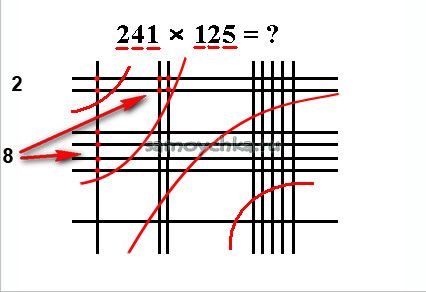
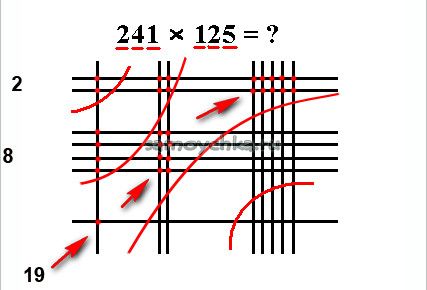
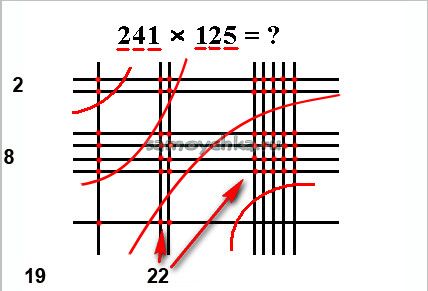
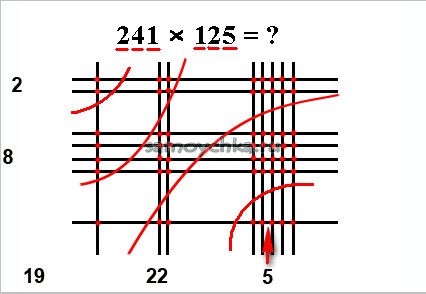
We got unambiguous and double figures in sectors. Now we need to transfer tens in two-digit numbers.
We move from right to left. 5 - unambiguous, let's leave it for now. Next 22 is two-digit. We carry the tens to the next number by addition.
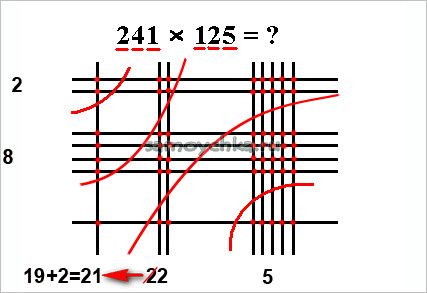
It turned out to be double digit again. We transfer tens again.
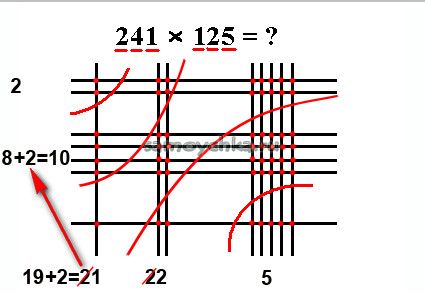
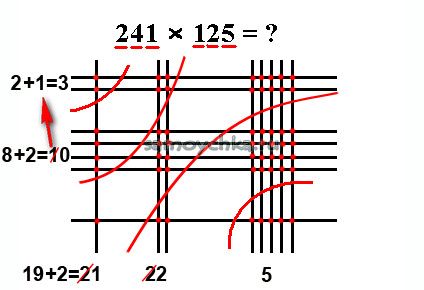
We move the tens until all sectors have single digit numbers.
 And finally we rewrite the result from left to right.
And finally we rewrite the result from left to right.
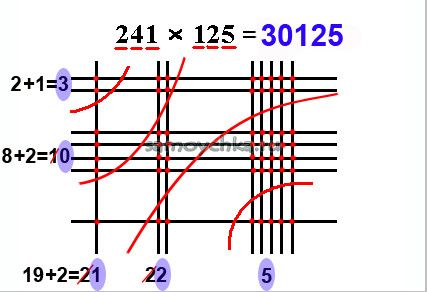
We got 30125. You can check the result on the calculator to see if it is correct. IN in this example we multiplied three digit numbers. But this method can be used for any multi-digit numbers.
This method seems quite confusing and time-consuming, but it is not. Try multiplying with it a couple of times and then multiplying multi-digit numbers will take you very little time.
problem: understand the types of multiplication
Target: familiarization with various methods of multiplying natural numbers not used in lessons, and their application in calculating numerical expressions.
Tasks:
1. Find and analyze different methods of multiplication.
2. Learn to demonstrate some methods of multiplication.
3. Talk about new ways of multiplication and teach students how to use them.
4. Develop skills independent work: information search, selection and design of found material.
5. Experiment “which method is faster”
Hypothesis:Do I need to know the multiplication table?
Relevance: Recently, students trust gadgets more than themselves. And this is why they count only on calculators. We wanted to show that there are different ways of multiplication, so that it would be easier for students to count and interesting to learn.
INTRODUCTION
You won't be able to multiply multi-digit numbers—even double-digit numbers—if you don't memorize all the multiplication results. single digit numbers, i.e. what is called the multiplication table.
At different times different peoples owned in different ways multiplication of natural numbers.
Why do all peoples now use one method of multiplication “column”?
Why did people abandon old methods of multiplication in favor of modern ones?
Do forgotten methods of multiplication have a right to exist in our time?
To answer these questions I did the following work:
1. Using the Internet, I found information about some methods of multiplication that were used before.;
2. Studied the literature suggested by the teacher;
3. I solved a couple of examples using all the studied methods in order to find out their shortcomings;
4) Identified the most effective ones among them;
5. Conducted an experiment;
6. Drew conclusions.
1. Find and analyze different methods of multiplication.
Multiplication on fingers.
The Old Russian method of multiplying on fingers is one of the most commonly used methods, which was successfully used by Russian merchants for many centuries. They learned to multiply single-digit numbers from 6 to 9 on their fingers. In this case, it was enough to have basic finger counting skills in “units”, “pairs”, “threes”, “fours”, “fives” and “tens”. The fingers here served as an auxiliary computing device.
To do this, on one hand they extended as many fingers as the first factor exceeds the number 5, and on the second they did the same for the second factor. The remaining fingers were bent. Then the number (total) of extended fingers was taken and multiplied by 10, then the numbers were multiplied, showing how many fingers were bent, and the results were added up.
For example, let's multiply 7 by 8. In the example considered, 2 and 3 fingers will be bent. If you add up the number of bent fingers (2+3=5) and multiply the number of not bent ones (2 3=6), you will get the numbers of tens and units of the desired product 56, respectively. This way you can calculate the product of any single-digit numbers greater than 5.
Methods of multiplying numbers in different countries
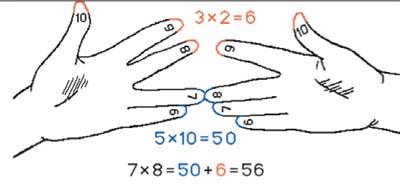
Multiply by 9.
Multiplication for the number 9 - 9 1, 9 2 ... 9 10 - is easier to forget from memory and more difficult to recalculate manually using the addition method, however, specifically for the number 9, multiplication is easily reproduced “on the fingers”. Spread your fingers on both hands and turn your hands with your palms facing away from you. Mentally assign numbers from 1 to 10 to your fingers, starting with the little finger of your left hand and ending with the little finger of your right hand (this is shown in the figure). 
Who invented multiplication on fingers
Let's say we want to multiply 9 by 6. We bend the finger with the number, equal to the number, by which we will multiply nine. In our example, we need to bend the finger with number 6. The number of fingers to the left of the bent finger shows us the number of tens in the answer, the number of fingers to the right shows the number of ones. On the left we have 5 fingers not bent, on the right - 4 fingers. Thus, 9·6=54. The figure below shows in detail the entire principle of “calculation”. 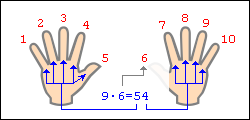
Multiplying in an unusual way
Another example: you need to calculate 9·8=?. Along the way, let’s say that the fingers cannot necessarily act as a “calculating machine”. Take, for example, 10 cells in a notebook. Cross out the 8th cell. There are 7 cells left on the left, 2 cells on the right. So 9·8=72. It's very simple.
7 cells 2 cells.
Indian way of multiplication.
The most valuable contribution to the treasury of mathematical knowledge was made in India. The Hindus proposed the method we use to write numbers using ten signs: 1, 2, 3, 4, 5, 6, 7, 8, 9, 0.
The basis of this method is the idea that the same digit represents units, tens, hundreds or thousands, depending on where the digit occupies. The occupied space, in the absence of any digits, is determined by the zeros assigned to the numbers.
The Indians were great at counting. They came up with a very simple way to multiply. They performed multiplication starting from the most significant digit, and wrote down incomplete products just above the multiplicand, bit by bit. In this case, the most significant digit of the complete product was immediately visible and, in addition, the omission of any digit was eliminated. The multiplication sign was not yet known, so they left a small distance between the factors. For example, let's multiply them using the method 537 by 6:
(5 ∙ 6 =30) 30
(300 + 3 ∙ 6 = 318) 318
(3180 +7 ∙ 6 = 3222) 3222
6
Multiplication using the “SMALL CASTLE” method.
Multiplication of numbers is now studied in the first grade of school. But in the Middle Ages, very few mastered the art of multiplication. It was a rare aristocrat who could boast of knowing the multiplication tables, even if he graduated from a European university.
Over the millennia of development of mathematics, many ways of multiplying numbers have been invented. The Italian mathematician Luca Pacioli, in his treatise “Summa of Arithmetic, Ratios and Proportionality” (1494), gives eight different methods of multiplication. The first of them is called “Little Castle”, and the second is no less romanticly called “Jealousy or lattice multiplication”.
The advantage of the “Little Castle” multiplication method is that the most significant digits are determined from the very beginning, and this can be important if you need to quickly estimate a value.
The digits of the upper number, starting from the most significant digit, are multiplied in turn by the lower number and written in a column with the required number of zeros added. The results are then added up. 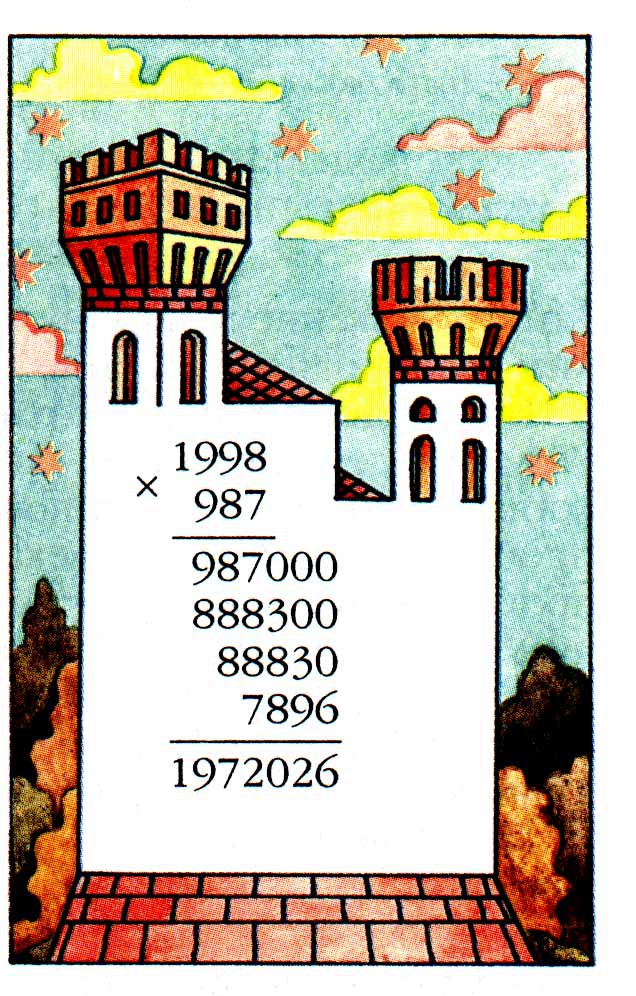
Methods of multiplying numbers in different countries
Multiplying numbers using the “jealousy” method.
“Methods of multiplication The second method has the romantic name jealousy,” or “lattice multiplication.”
First, a rectangle is drawn, divided into squares, and the dimensions of the sides of the rectangle correspond to the number of decimal places of the multiplicand and the multiplier. Then the square cells are divided diagonally, and “... the result is a picture similar to lattice shutters,” writes Pacioli. “Such shutters were hung on the windows of Venetian houses, preventing street passers-by from seeing the ladies and nuns sitting at the windows.”
Let's multiply 347 by 29 in this way. Let's draw a table, write the number 347 above it, and the number 29 on the right.
In each line we will write the product of the numbers above this cell and to the right of it, while we will write the tens digit of the product above the slash, and the units digit below it. Now we add the numbers in each oblique strip, performing this operation, from right to left. If the amount is less than 10, then we write it under the bottom number of the strip. If it turns out to be greater than 10, then we write only the units digit of the sum, and add the tens digit to the next sum. As a result, we obtain the desired product 10063.
Peasant method of multiplication.
The most “native” and easiest way of multiplication, in my opinion, is the method used by Russian peasants. This technique does not require knowledge of the multiplication table beyond the number 2 at all. Its essence is that the multiplication of any two numbers is reduced to a series of successive divisions of one number in half while simultaneously doubling the other number. Dividing in half continues until the quotient reaches 1, while simultaneously doubling the other number. The last doubled number gives the desired result.
If the number is odd, remove one and divide the remainder in half; but to the last number of the right column you will need to add all those numbers of this column that stand opposite the odd numbers of the left column: the sum will be the desired product
The product of all pairs of corresponding numbers is the same, so
37 ∙ 32 = 1184 ∙ 1 = 1184
In the case when one of the numbers is odd or both numbers are odd, proceed as follows:
384 ∙ 1 = 384
24 ∙ 17 = 24∙(16+1)=24 ∙ 16 + 24 = 384 + 24 = 408
A new way to multiply.
Interesting new way multiplication, which has recently been reported. The inventor of the new mental counting system, Candidate of Philosophy Vasily Okoneshnikov, claims that a person is able to remember a huge amount of information, the main thing is how to arrange this information. According to the scientist himself, the most advantageous in this regard is the nine-fold system - all data is simply placed in nine cells, located like buttons on a calculator.
It is very easy to calculate using such a table. For example, let's multiply the number 15647 by 5. In the part of the table corresponding to five, select the numbers corresponding to the digits of the number in order: one, five, six, four and seven. We get: 05 25 30 20 35
We leave the left digit (zero in our example) unchanged, and add the following numbers in pairs: five with a two, five with a three, zero with a two, zero with a three. The last digit is also unchanged.
As a result, we get: 078235. The number 78235 is the result of multiplication.
If, when adding two digits, a number greater than nine is obtained, then its first digit is added to the previous digit of the result, and the second is written in its “own” place.
Conclusion.
While working on this topic, I learned that there are about 30 different, fun and interesting ways to multiply. Some in various countries are still in use today. I have chosen some interesting ways for myself. But not all methods are convenient to use, especially when multiplying multi-digit numbers.
Multiplication methods

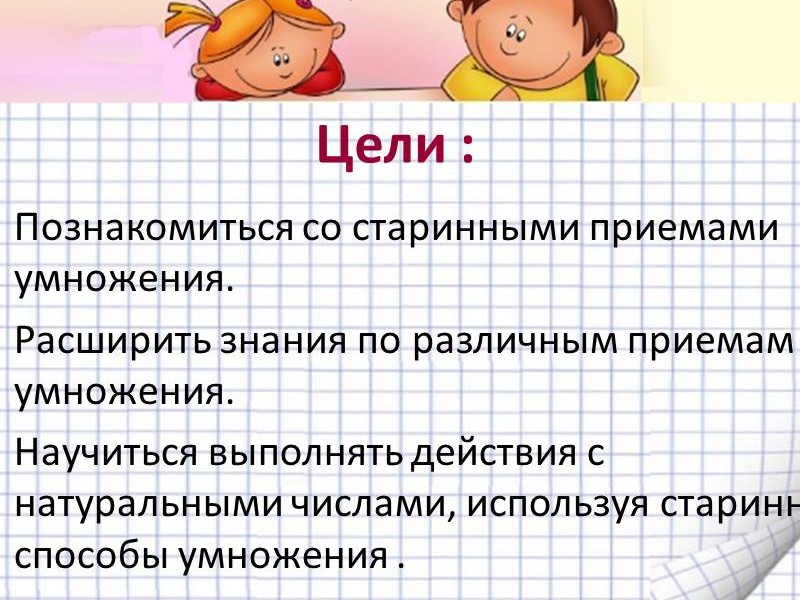


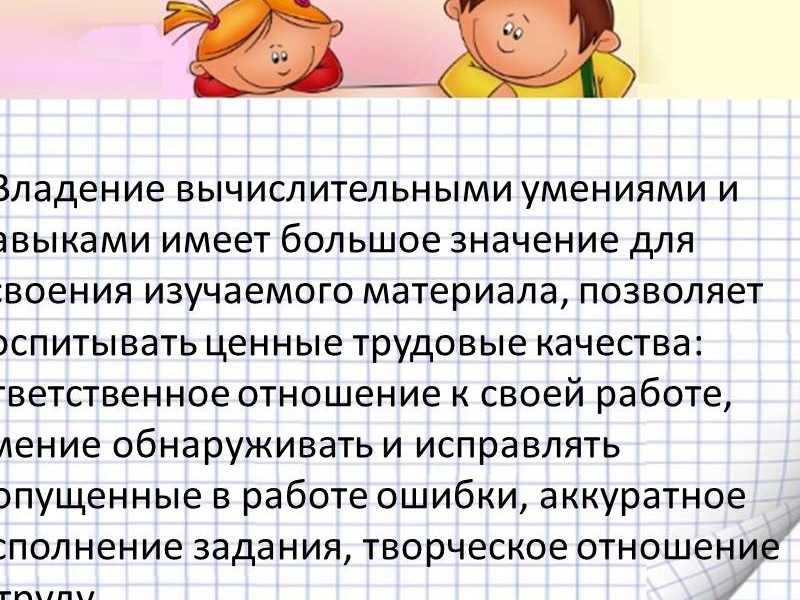

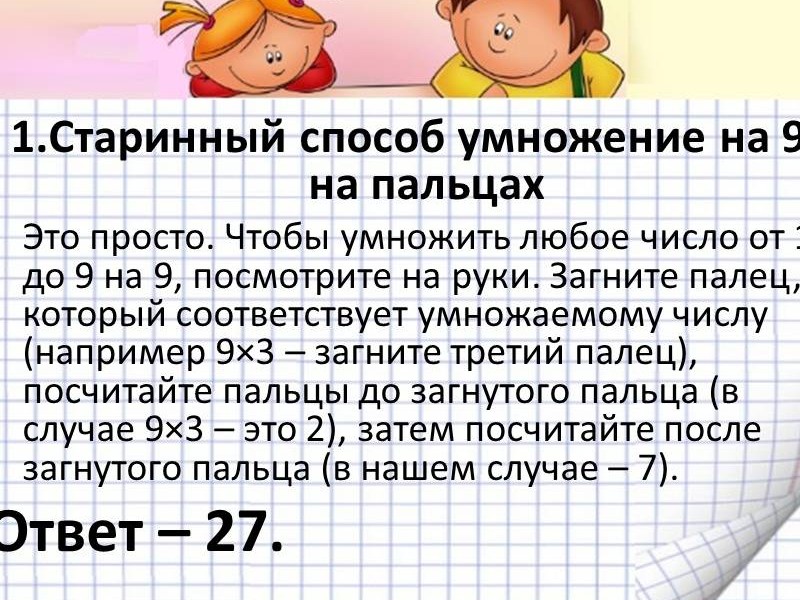
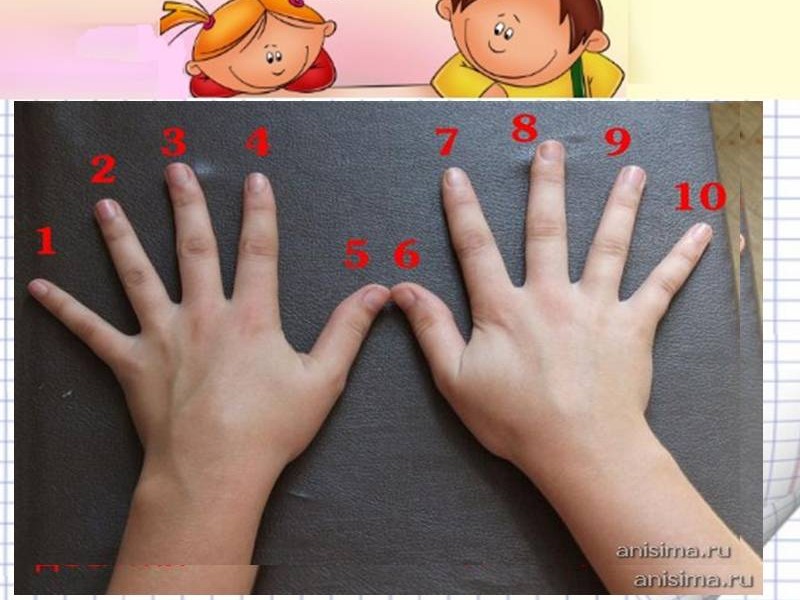
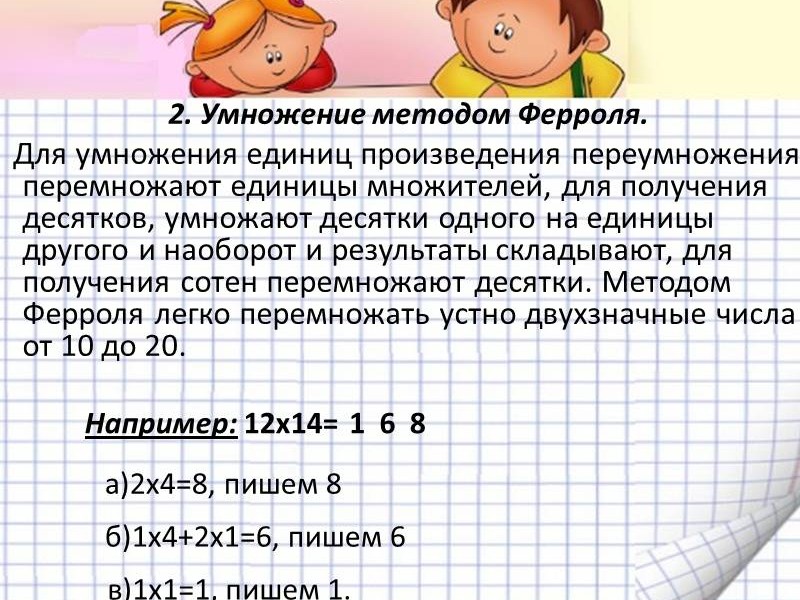
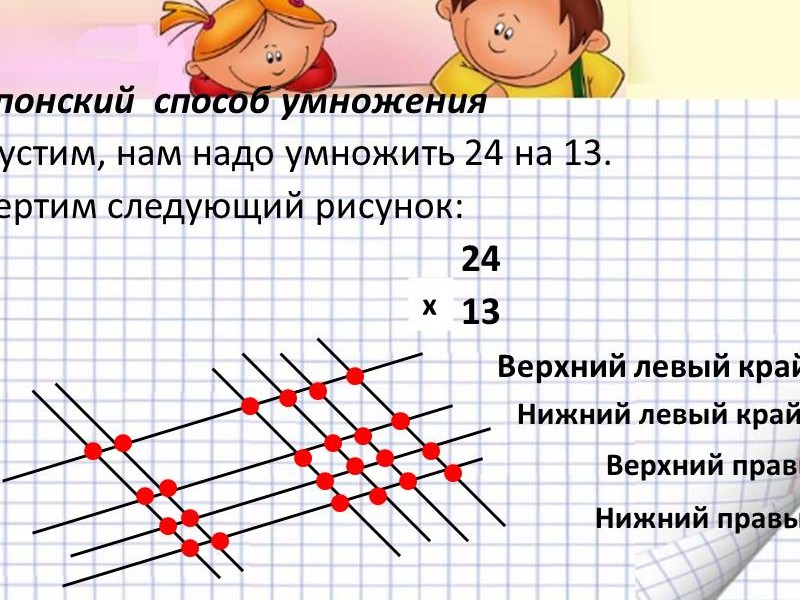
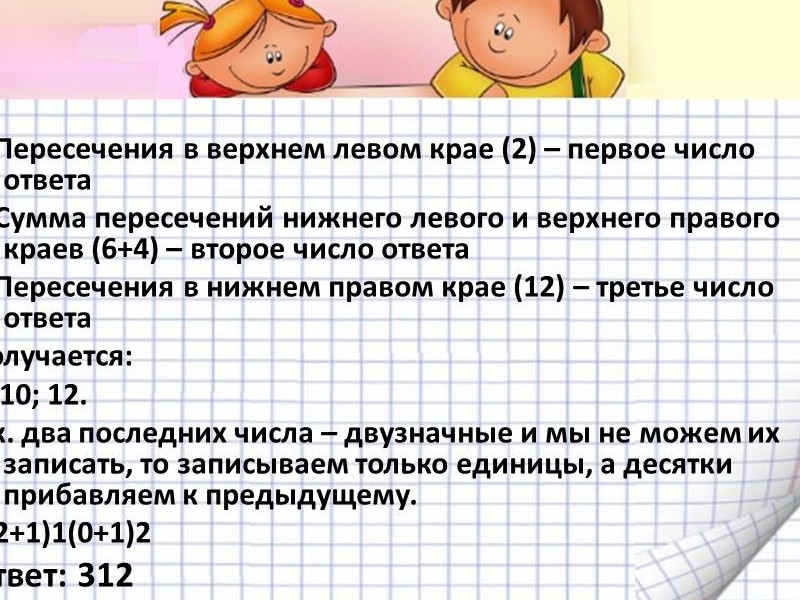
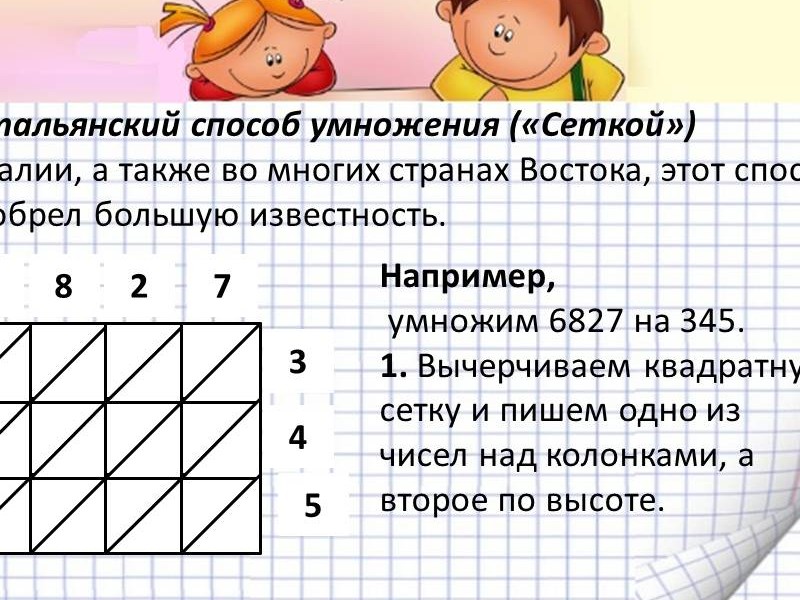
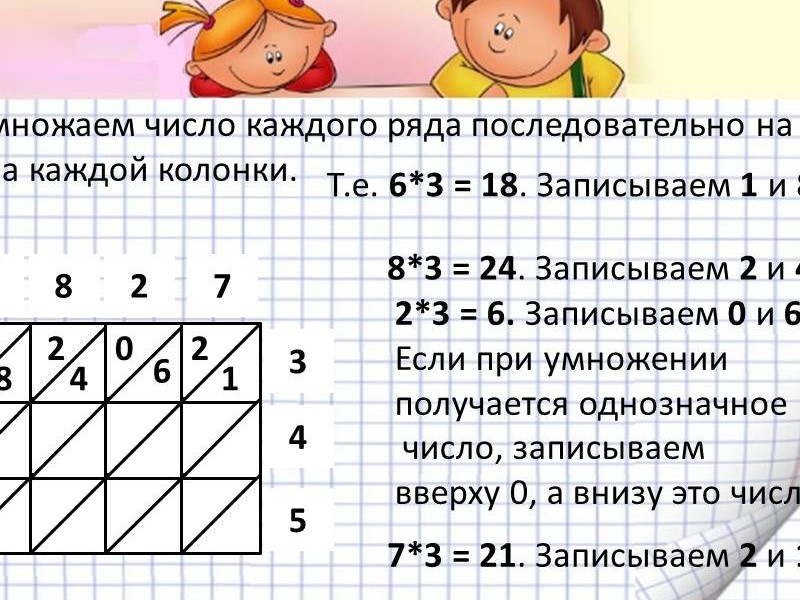
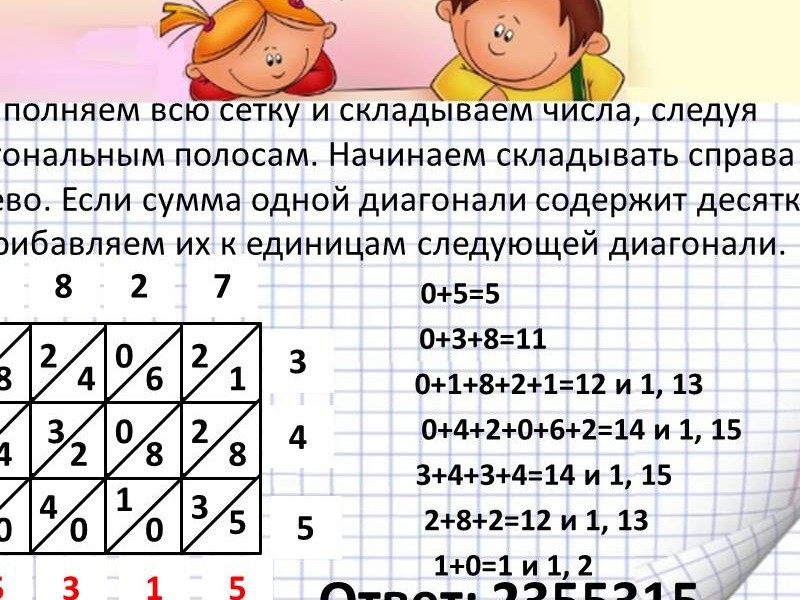

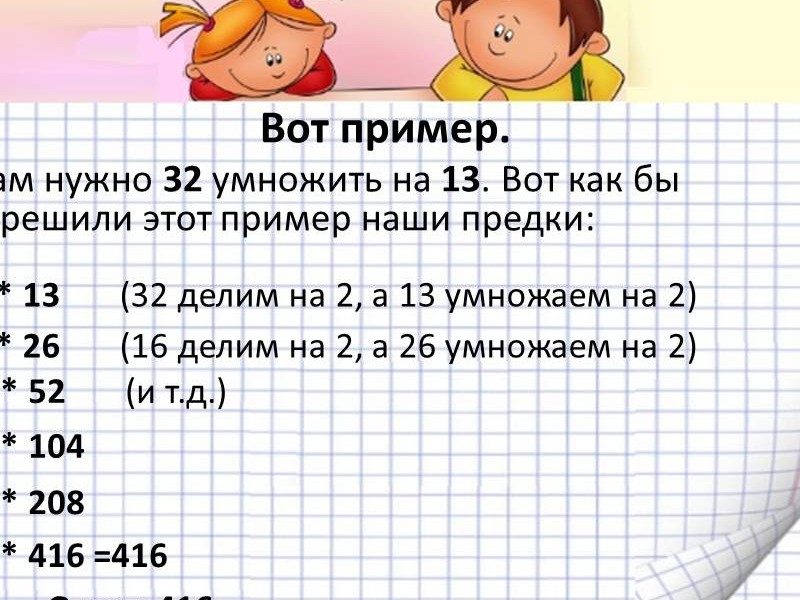
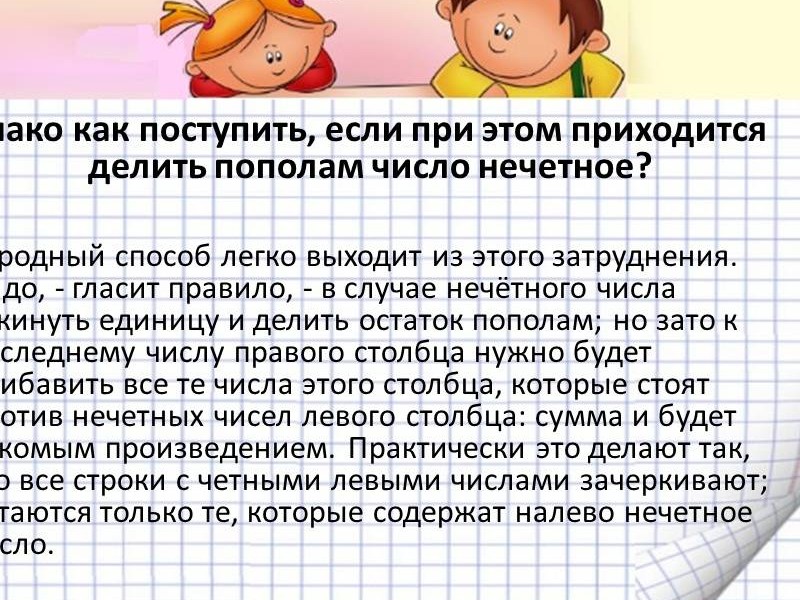
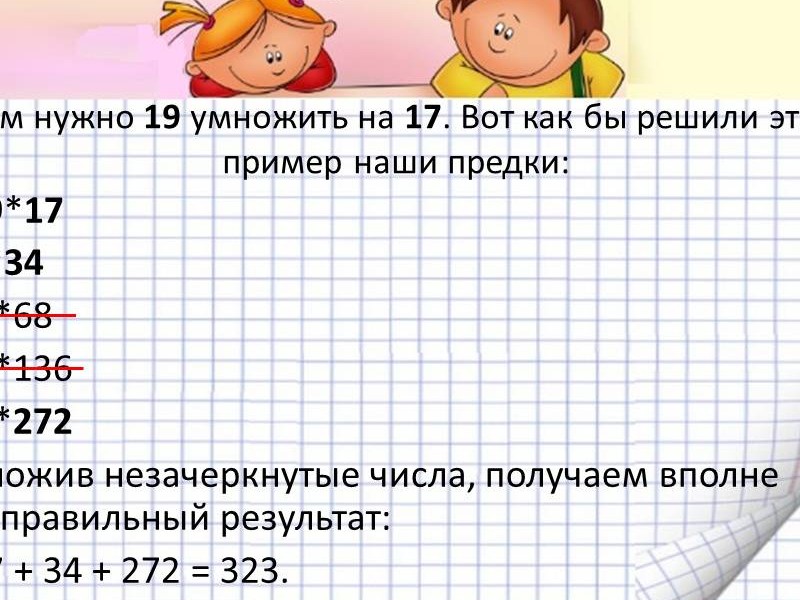
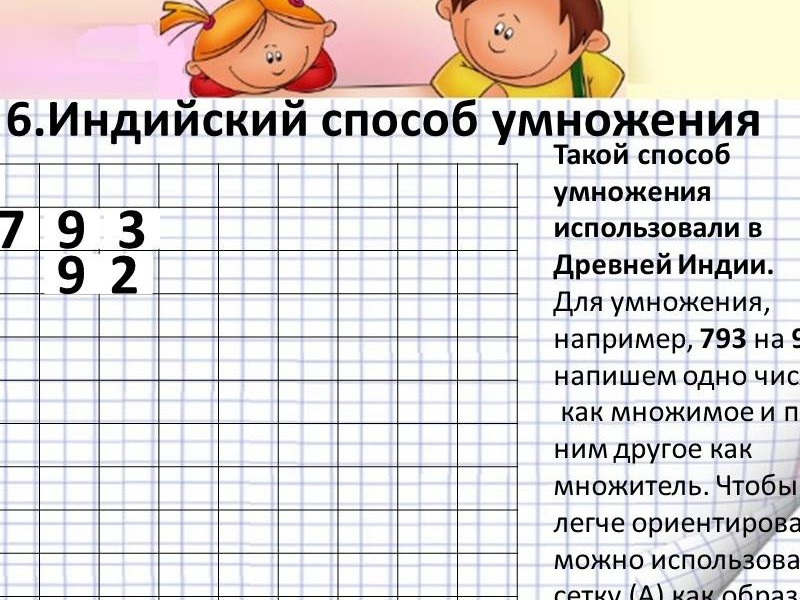
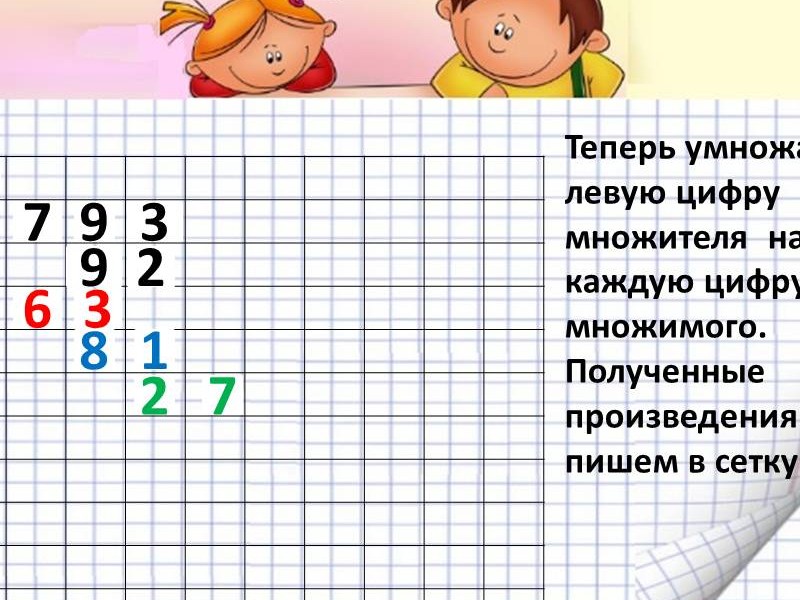
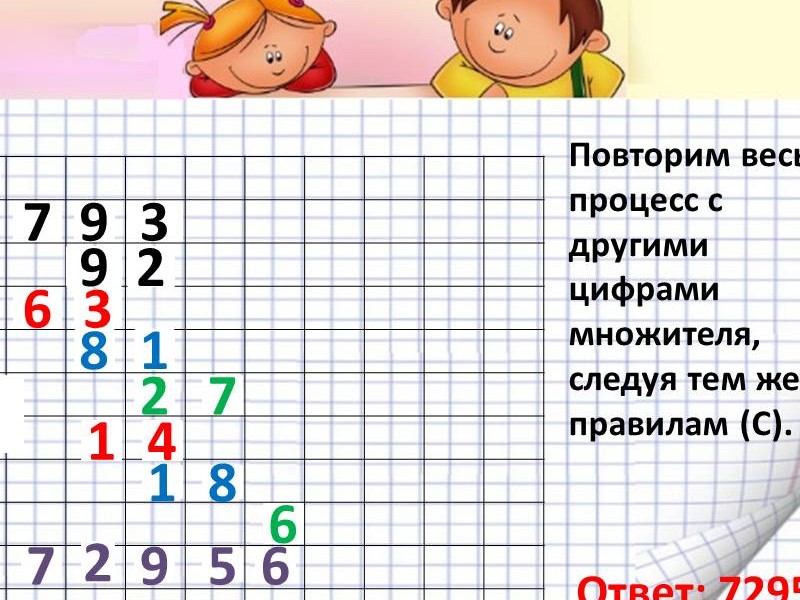
 Back Forward
Back Forward
Attention! Slide previews are for informational purposes only and may not represent all the features of the presentation. If you are interested in this work, please download the full version.
“Counting and calculations are the basis of order in the head.”
Pestalozzi
Target:
- Learn ancient multiplication techniques.
- Expand your knowledge of various multiplication techniques.
- Learn to perform operations with natural numbers using ancient methods of multiplication.
- The old way of multiplying by 9 on your fingers
- Multiplication by Ferrol method.
- Japanese way of multiplication.
- Italian way of multiplication (“Grid”)
- Russian method of multiplication.
- Indian way of multiplication.
Progress of the lesson
The relevance of using fast counting techniques.
In modern life, each person often has to perform a huge number of calculations and calculations. Therefore, the goal of my work is to show easy, fast and accurate methods of counting, which will not only help you during any calculations, but will cause considerable surprise among acquaintances and comrades, because the free performance of counting operations can largely indicate the extraordinary nature of your intellect. A fundamental element of computing culture is conscious and robust computing skills. The problem of developing a computing culture is relevant for the entire school mathematics course, starting from the primary grades, and requires not just mastering computing skills, but using them in various situations. Possession of computational skills is of great importance for mastering the material being studied and allows one to develop valuable work qualities: a responsible attitude to one’s work, the ability to detect and correct errors made in the work, careful execution of a task, a creative attitude to work. However, recently the level of computational skills and transformations of expressions has a pronounced downward trend, students make a lot of mistakes when calculating, increasingly use a calculator, and do not think rationally, which negatively affects the quality of education and the level of mathematical knowledge of students in general. One of the components of computing culture is mental counting, which is of great importance. The ability to quickly and correctly make simple calculations “in the head” is necessary for every person.
Ancient ways of multiplying numbers.
1. The old way of multiplying by 9 on your fingers
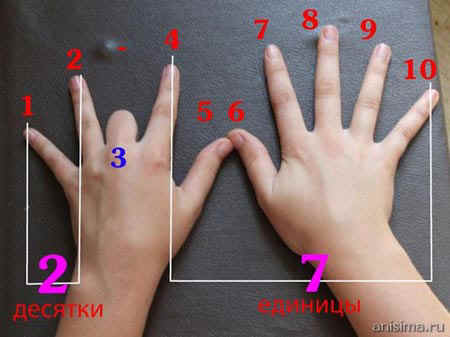
It's simple. To multiply any number from 1 to 9 by 9, look at your hands. Fold the finger that corresponds to the number being multiplied (for example, 9 x 3 - fold the third finger), count the fingers before the folded finger (in the case of 9 x 3, this is 2), then count after the folded finger (in our case, 7). The answer is 27.
2. Multiplication by the Ferrol method.
To multiply the units of the product of remultiplication, the units of the factors are multiplied; to obtain tens, the tens of one are multiplied by the units of the other and vice versa and the results are added; to obtain hundreds, the tens are multiplied. Using the Ferrol method, it is easy to multiply two-digit numbers from 10 to 20 verbally.
For example: 12x14=168
a) 2x4=8, write 8
b) 1x4+2x1=6, write 6
c) 1x1=1, write 1.
3. Japanese way of multiplication
This technique is reminiscent of multiplication by a column, but it takes quite a long time.
Using the technique. Let's say we need to multiply 13 by 24. Let's draw the following figure:
This drawing consists of 10 lines (the number can be any)
- These lines represent the number 24 (2 lines, indent, 4 lines)
- And these lines represent the number 13 (1 line, indent, 3 lines)
(intersections in the figure are indicated by dots)

Number of crossings:
- Top left edge: 2
- Bottom left edge: 6
- Top right: 4
- Bottom right: 12
1) Intersections in the upper left edge (2) – the first number of the answer
2) The sum of the intersections of the lower left and upper right edges (6+4) – the second number of the answer
3) Intersections in the lower right edge (12) – the third number of the answer.
It turns out: 2; 10; 12.
Because two last numbers- are two-digit and we cannot write them down, then we write down only ones, and add tens to the previous one.
4. Italian way of multiplication (“Grid”)
In Italy, as well as in many Eastern countries, this method has gained great popularity.
Using the technique:
For example, let's multiply 6827 by 345.
1. Draw a square grid and write one of the numbers above the columns, and the second in height.
2. Multiply the number of each row sequentially by the numbers of each column.
- 6*3 = 18. Write 1 and 8
- 8*3 = 24. Write 2 and 4
If multiplication results in a single-digit number, write 0 at the top and this number at the bottom.
(As in our example, when multiplying 2 by 3, we got 6. We wrote 0 at the top and 6 at the bottom)
3. Fill in the entire grid and add up the numbers following the diagonal stripes. We start folding from right to left. If the sum of one diagonal contains tens, then add them to the units of the next diagonal.
Answer: 2355315.
5. Russian method of multiplication.
This multiplication technique was used by Russian peasants approximately 2-4 centuries ago, and was developed in ancient times. The essence of this method is: “As much as we divide the first factor, we multiply the second by that much.” Here is an example: We need to multiply 32 by 13. This is how our ancestors would have solved this example 3-4 centuries ago:
- 32 * 13 (32 divided by 2, and 13 multiplied by 2)
- 16 * 26 (16 divided by 2, and 26 multiplied by 2)
- 8 * 52 (etc.)
- 4 * 104
- 2 * 208
- 1 * 416 =416
Dividing in half continues until the quotient reaches 1, while simultaneously doubling the other number. The last doubled number gives the desired result. It is not difficult to understand what this method is based on: the product does not change if one factor is halved and the other is doubled. It is therefore clear that as a result of repeated repetition of this operation, the desired product is obtained
However, what should you do if you have to divide an odd number in half? The folk method easily overcomes this difficulty. It is necessary, says the rule, in case of an odd number, discard one and divide the remainder in half; but then to the last number of the right column you will need to add all those numbers of this column that stand opposite the odd numbers of the left column: the sum will be the desired product. In practice, this is done in such a way that all lines with even left numbers are crossed out; Only those that contain an odd number to the left remain. Here's an example (asterisks indicate that this line should be crossed out):
- 19*17
- 4 *68*
- 2 *136*
- 1 *272
Adding the uncrossed numbers, we get a completely correct result:
- 17 + 34 + 272 = 323.
Answer: 323.
6. Indian way of multiplication.
This method of multiplication was used in Ancient India.
To multiply, for example, 793 by 92, we write one number as the multiplicand and below it another as the multiplier. To make it easier to navigate, you can use the grid (A) as a reference.
Now we multiply the left digit of the multiplier by each digit of the multiplicand, that is, 9x7, 9x9 and 9x3. We write the resulting products in grid (B), keeping in mind the following rules:
- Rule 1. The units of the first product should be written in the same column as the factor, that is, in in this case under 9.
- Rule 2. Subsequent works must be written in such a way that the units are placed in the column immediately to the right of the previous work.
Let's repeat the whole process with other digits of the multiplier, following the same rules (C).
Then we add up the numbers in the columns and get the answer: 72956.
As you can see, we get a large list of works. The Indians, who had extensive practice, wrote each number not in the corresponding column, but on top, as far as possible. Then they added the numbers in the columns and got the result.
Conclusion
We have entered a new millennium! Grand discoveries and achievements of mankind. We know a lot, we can do a lot. It seems something supernatural that with the help of numbers and formulas one can calculate the flight of a spaceship, the “economic situation” in the country, the weather for “tomorrow”, and describe the sound of notes in a melody. We know the statement of the ancient Greek mathematician and philosopher who lived in the 4th century BC - Pythagoras - “Everything is a number!”
According to the philosophical view of this scientist and his followers, numbers govern not only measure and weight, but also all phenomena occurring in nature, and are the essence of harmony reigning in the world, the soul of the cosmos.
Describing ancient methods of calculation and modern methods of quick calculation, I tried to show that both in the past and in the future, one cannot do without mathematics, a science created by the human mind.
“Whoever studies mathematics from childhood develops attention, trains the brain, his will, and cultivates perseverance and perseverance in achieving goals.”(A. Markushevich)
Literature.
- Encyclopedia for children. "T.23". Universal Encyclopedic Dictionary \ ed. board: M. Aksenova, E. Zhuravleva, D. Lyury and others - M.: World of Encyclopedias Avanta +, Astrel, 2008. - 688 p.
- Ozhegov S.I. Dictionary of the Russian language: approx. 57,000 words / Ed. member - corr. ANSIR N.YU. Shvedova. – 20th ed. – M.: Education, 2000. – 1012 p.
- I want to know everything! Large illustrated encyclopedia of intelligence / Transl. from English A. Zykova, K. Malkova, O. Ozerova. – M.: Publishing house ECMO, 2006. – 440 p.
- Sheinina O.S., Solovyova G.M. Mathematics. School club classes 5-6 grades / O.S. Sheinina, G.M. Solovyova - M.: Publishing house NTsENAS, 2007. - 208 p.
- Kordemsky B. A., Akhadov A. A. Amazing world numbers: Book of students, - M. Education, 1986.
- Minskikh E. M. “From game to knowledge”, M., “Enlightenment” 1982.
- Svechnikov A. A. Numbers, figures, problems M., Education, 1977.
- http://matsievsky. newmail. ru/sys-schi/file15.htm
- http://sch69.narod. ru/mod/1/6506/hystory. html
Municipal educational institution "Kurovskaya secondary school No. 6"
ABSTRACT ON MATHEMATICS ON THE TOPIC:
« UNUSUAL WAYS OF MULTIPLICATION».
Completed by a student of grade 6 “b”
Krestnikov Vasily.
Supervisor:
Smirnova Tatyana Vladimirovna.
Introduction…………………………………………………………………………2
Main part. Unusual ways multiplication…………………………3
2.1. A little history……………………………………………………………..3
2.2. Multiplication on fingers………………………………………………………4
2.3. Multiplication by 9…………………………………………………………………………………5
2.4. Indian way of multiplication…………………………………………….6
2.5. Multiplication using the “Small Castle” method…………………………………7
2.6. Multiplication using the “Jealousy” method………………………………………………………8
2.7. Peasant method of multiplication……………………………………………..9
2.8 New way…………………………………………………………………………………..10
Conclusion…………………………………………………………………………………11
References…………………………………………………………….1 2
I. Introduction.
It is impossible for a person to do without calculations in everyday life. Therefore, in mathematics lessons, we are first of all taught to perform operations on numbers, that is, to count. We multiply, divide, add and subtract in the usual ways that are studied at school.
One day I accidentally came across a book by S. N. Olehnik, Yu. V. Nesterenko and M. K. Potapov “Ancient entertaining tasks" Leafing through this book, my attention was drawn to a page called “Multiplication on the fingers.” It turned out that you can multiply not only as suggested to us in mathematics textbooks. I was wondering if there were any other methods of calculation. After all, the ability to quickly perform calculations is frankly surprising.
The constant use of modern computer technology leads to the fact that students find it difficult to make any calculations without having tables or a calculating machine at their disposal. Knowledge of simplified calculation techniques makes it possible not only to quickly perform simple calculations in the mind, but also to control, evaluate, find and correct errors as a result of mechanized calculations. In addition, mastering computational skills develops memory, increases the level of mathematical culture of thinking, and helps to fully master the subjects of the physical and mathematical cycle.
Purpose of the work:
Show unusualmethods of multiplication.
Tasks:
Find as many as possibleunusual methods of calculations.
Learn to use them.
Choose for yourself the most interesting or easier ones than those thatare offeredat school, and use them when counting.
II. Main part. Unusual ways of multiplication.
2.1. A little history.
The methods of calculation that we use now were not always so simple and convenient. In the old days, more cumbersome and slower techniques were used. And if a schoolchild of the 21st century could travel back five centuries, he would amaze our ancestors with the speed and accuracy of his calculations. Rumors about him would have spread throughout the surrounding schools and monasteries, eclipsing the glory of the most skilled calculators of that era, and people would come from all over to study with the new great master.
The operations of multiplication and division were especially difficult in the old days. Then there was no one method developed by practice for each action. On the contrary, there were almost a dozen different methods of multiplication and division in use at the same time - techniques one more complicated than the other, which a person of average ability was not able to remember. Each teacher of counting stuck to his favorite technique, each “master of division” (there were such specialists) praised his own way of performing this action.
In V. Bellustin’s book “How people gradually reached real arithmetic,” 27 methods of multiplication are outlined, and the author notes: “it is very possible that there are other methods hidden in the recesses of book depositories, scattered in numerous, mainly handwritten collections.”
And all these methods of multiplication - “chess or organ”, “folding”, “cross”, “lattice”, “back to front”, “diamond” and others competed with each other and were learned with great difficulty.
Let's look at the most interesting and simple ways multiplication.
2.2. Multiplication on fingers.
The Old Russian method of multiplying on fingers is one of the most commonly used methods, which was successfully used by Russian merchants for many centuries. They learned to multiply single-digit numbers from 6 to 9 on their fingers. In this case, it was enough to have basic finger counting skills in “units”, “pairs”, “threes”, “fours”, “fives” and “tens”. The fingers here served as an auxiliary computing device.
To do this, on one hand they extended as many fingers as the first factor exceeds the number 5, and on the second they did the same for the second factor. The remaining fingers were bent. Then the number (total) of extended fingers was taken and multiplied by 10, then the numbers were multiplied, showing how many fingers were bent, and the results were added up.
For example, let's multiply 7 by 8. In the example considered, 2 and 3 fingers will be bent. If you add up the number of bent fingers (2+3=5) and multiply the number of not bent ones (2 3=6), you will get the numbers of tens and units of the desired product 56, respectively. This way you can calculate the product of any single-digit numbers greater than 5.
2.3. Multiply by 9.
Multiplication for the number 9- 9 1, 9 2 ... 9 10 - is easier to forget from memory and more difficult to recalculate manually using the addition method, however, specifically for the number 9, multiplication is easily reproduced “on the fingers.” Spread your fingers on both hands and turn your hands with your palms facing away from you. Mentally assign numbers from 1 to 10 to your fingers, starting with the little finger of your left hand and ending with the little finger of your right hand (this is shown in the figure).

Let's say we want to multiply 9 by 6. We bend the finger with a number equal to the number by which we will multiply nine. In our example, we need to bend the finger with number 6. The number of fingers to the left of the bent finger shows us the number of tens in the answer, the number of fingers to the right shows the number of units. On the left we have 5 fingers not bent, on the right - 4 fingers. Thus, 9·6=54. The figure below shows in detail the entire principle of “calculation”.

Another example: you need to calculate 9·8=?. Along the way, let’s say that the fingers cannot necessarily act as a “calculating machine”. Take, for example, 10 cells in a notebook. Cross out the 8th cell. There are 7 cells left on the left, 2 cells on the right. So 9·8=72. It's very simple.
7 cells 2 cells.
2.4. Indian way of multiplication.
The most valuable contribution to the treasury of mathematical knowledge was made in India. The Hindus proposed the method we use to write numbers using ten signs: 1, 2, 3, 4, 5, 6, 7, 8, 9, 0.
The basis of this method is the idea that the same digit represents units, tens, hundreds or thousands, depending on where the digit occupies. The occupied space, in the absence of any digits, is determined by the zeros assigned to the numbers.
The Indians were great at counting. They came up with a very simple way to multiply. They performed multiplication starting from the most significant digit, and wrote down incomplete products just above the multiplicand, bit by bit. In this case, the most significant digit of the complete product was immediately visible and, in addition, the omission of any digit was eliminated. The multiplication sign was not yet known, so they left a small distance between the factors. For example, let's multiply them using the method 537 by 6:
(5 ∙ 6 =30) 30
(300 + 3 ∙ 6 = 318) 318
(3180 +7 ∙ 6 = 3222) 3222
2.5 . Multiplication way"LITTLE CASTLE".
Multiplication of numbers is now studied in the first grade of school. But in the Middle Ages, very few mastered the art of multiplication. It was a rare aristocrat who could boast of knowing the multiplication tables, even if he graduated from a European university.
Over the millennia of development of mathematics, many ways of multiplying numbers have been invented. The Italian mathematician Luca Pacioli, in his treatise “Summa of Arithmetic, Ratios and Proportionality” (1494), gives eight different methods of multiplication. The first of them is called “Little Castle”, and the second is no less romanticly called “Jealousy or lattice multiplication”.
The advantage of the “Little Castle” multiplication method is that the most significant digits are determined from the very beginning, and this can be important if you need to quickly estimate a value.
The digits of the upper number, starting from the most significant digit, are multiplied in turn by the lower number and written in a column with the required number of zeros added. The results are then added up.

2.6. Multiplying numbersusing the "jealousy" method.
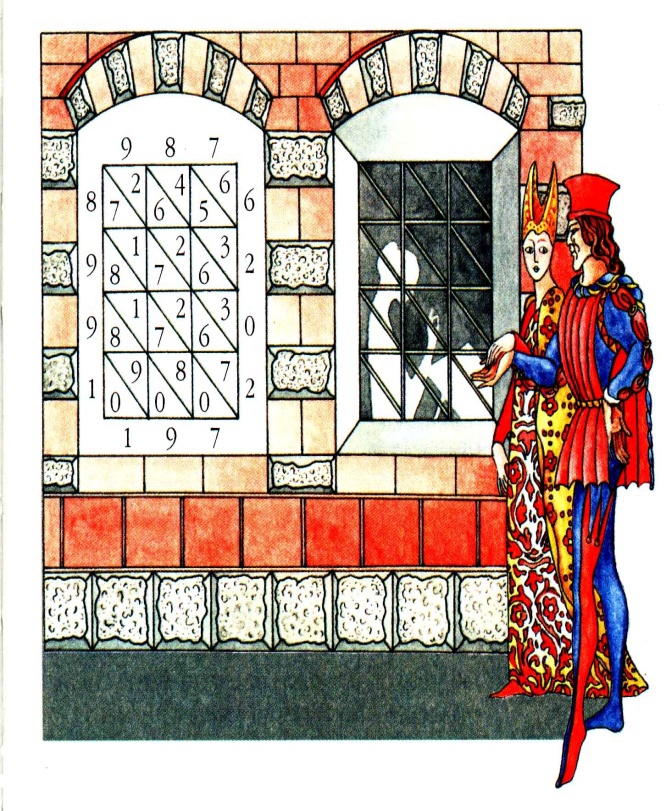 The second method has the romantic name “jealousy”, or “lattice multiplication”.
The second method has the romantic name “jealousy”, or “lattice multiplication”.
First, a rectangle is drawn, divided into squares, and the dimensions of the sides of the rectangle correspond to the number of decimal places of the multiplicand and the multiplier. Then the square cells are divided diagonally, and “... the result is a picture similar to lattice shutters,” writes Pacioli. “Such shutters were hung on the windows of Venetian houses, preventing street passers-by from seeing the ladies and nuns sitting at the windows.”
Let's multiply 347 by 29 in this way. Let's draw a table, write the number 347 above it, and the number 29 on the right.
In each line we will write the product of the numbers above this cell and to the right of it, while we will write the tens digit of the product above the slash, and the units digit below it. Now we add the numbers in each oblique strip, performing this operation, from right to left. If the amount is less than 10, then we write it under the bottom number of the strip. If it turns out to be greater than 10, then we write only the units digit of the sum, and add the tens digit to the next sum. As a result, we obtain the desired product 10063.
2.7. TOpeasant method of multiplication.
The most “native” and easiest way of multiplication, in my opinion, is the method used by Russian peasants. This technique does not require knowledge of the multiplication table beyond the number 2 at all. Its essence is that the multiplication of any two numbers is reduced to a series of successive divisions of one number in half while simultaneously doubling the other number. Dividing in half continues until the quotient reaches 1, while simultaneously doubling the other number. The last doubled number gives the desired result.
If the number is odd, remove one and divide the remainder in half; but to the last number of the right column you will need to add all those numbers of this column that stand opposite the odd numbers of the left column: the sum will be the desired product
The product of all pairs of corresponding numbers is the same, so
37 ∙ 32 = 1184 ∙ 1 = 1184
In the case when one of the numbers is odd or both numbers are odd, proceed as follows:
384 ∙ 1 = 384
24 ∙ 17 = 24∙(16+1)=24 ∙ 16 + 24 = 384 + 24 = 408
2.8 . A new way to multiply.
Interesting a new method of multiplication that has recently been reported. The inventor of the new mental counting system, Candidate of Philosophy Vasily Okoneshnikov, claims that a person is able to remember a huge amount of information, the main thing is how to arrange this information. According to the scientist himself, the most advantageous in this regard is the nine-fold system - all data is simply placed in nine cells, located like buttons on a calculator.
It is very easy to calculate using such a table. For example, let's multiply the number 15647 by 5. In the part of the table corresponding to five, select the numbers corresponding to the digits of the number in order: one, five, six, four and seven. We get: 05 25 30 20 35
We leave the left digit (zero in our example) unchanged, and add the following numbers in pairs: five with a two, five with a three, zero with a two, zero with a three. The last digit is also unchanged.
As a result, we get: 078235. The number 78235 is the result of multiplication.
If, when adding two digits, a number greater than nine is obtained, then its first digit is added to the previous digit of the result, and the second is written in its “own” place.
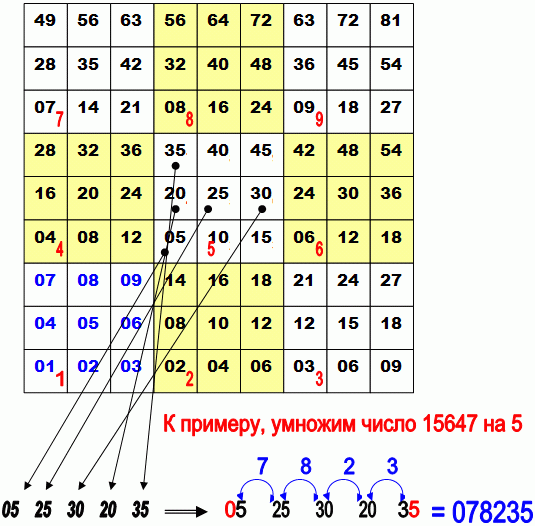
III. Conclusion.
Of all the unusual counting methods I found, the “lattice multiplication or jealousy” method seemed more interesting. I showed it to my classmates and they really liked it too.
The simplest method seemed to me to be “doubling and splitting”, which was used by Russian peasants. I don't use it too much when multiplying. large numbers(it is very convenient to use when multiplying two-digit numbers).
I was interested in the new method of multiplication, because it allows me to “toss around” huge numbers in my mind.
I think that our method of multiplying by column is not perfect and we can come up with even faster and more reliable methods.
Literature.
Depman I. “Stories about mathematics.” – Leningrad: Education, 1954. – 140 p.
Korneev A.A. The phenomenon of Russian multiplication. Story. http://numbernautics.ru/
Olehnik S. N., Nesterenko Yu. V., Potapov M. K. “Old entertaining problems.” – M.: Science. Main editorial office of physical and mathematical literature, 1985. – 160 p.
Perelman Ya.I. Quick count. Thirty simple mental counting techniques. L., 1941 - 12 p.
Perelman Ya.I. Interesting arithmetic. M. Rusanova, 1994—205 p.
Encyclopedia “I explore the world. Mathematics". – M.: Astrel Ermak, 2004.
Encyclopedia for children. "Mathematics". – M.: Avanta +, 2003. – 688 p.





















 Back Forward
Back Forward
Attention! Slide previews are for informational purposes only and may not represent all the features of the presentation. If you are interested in this work, please download the full version.
“Counting and calculations are the basis of order in the head.”
Pestalozzi
Target:
- Learn ancient multiplication techniques.
- Expand your knowledge of various multiplication techniques.
- Learn to perform operations with natural numbers using ancient methods of multiplication.
- The old way of multiplying by 9 on your fingers
- Multiplication by Ferrol method.
- Japanese way of multiplication.
- Italian way of multiplication (“Grid”)
- Russian method of multiplication.
- Indian way of multiplication.
Progress of the lesson
The relevance of using fast counting techniques.
In modern life, each person often has to perform a huge number of calculations and calculations. Therefore, the goal of my work is to show easy, fast and accurate methods of counting, which will not only help you during any calculations, but will cause considerable surprise among acquaintances and comrades, because the free performance of counting operations can largely indicate the extraordinary nature of your intellect. A fundamental element of computing culture is conscious and robust computing skills. The problem of developing a computing culture is relevant for the entire school mathematics course, starting from the primary grades, and requires not just mastering computing skills, but using them in various situations. Possession of computational skills is of great importance for mastering the material being studied and allows one to develop valuable work qualities: a responsible attitude to one’s work, the ability to detect and correct errors made in the work, careful execution of a task, a creative attitude to work. However, recently the level of computational skills and transformations of expressions has a pronounced downward trend, students make a lot of mistakes when calculating, increasingly use a calculator, and do not think rationally, which negatively affects the quality of education and the level of mathematical knowledge of students in general. One of the components of computing culture is mental counting, which is of great importance. The ability to quickly and correctly make simple calculations “in the head” is necessary for every person.
Ancient ways of multiplying numbers.
1. The old way of multiplying by 9 on your fingers
It's simple. To multiply any number from 1 to 9 by 9, look at your hands. Fold the finger that corresponds to the number being multiplied (for example, 9 x 3 - fold the third finger), count the fingers before the folded finger (in the case of 9 x 3, this is 2), then count after the folded finger (in our case, 7). The answer is 27.
2. Multiplication by the Ferrol method.
To multiply the units of the product of remultiplication, the units of the factors are multiplied; to obtain tens, the tens of one are multiplied by the units of the other and vice versa and the results are added; to obtain hundreds, the tens are multiplied. Using the Ferrol method, it is easy to multiply two-digit numbers from 10 to 20 verbally.
For example: 12x14=168
a) 2x4=8, write 8
b) 1x4+2x1=6, write 6
c) 1x1=1, write 1.
3. Japanese way of multiplication
This technique is reminiscent of multiplication by a column, but it takes quite a long time.
Using the technique. Let's say we need to multiply 13 by 24. Let's draw the following figure:
This drawing consists of 10 lines (the number can be any)
- These lines represent the number 24 (2 lines, indent, 4 lines)
- And these lines represent the number 13 (1 line, indent, 3 lines)
(intersections in the figure are indicated by dots)
Number of crossings:
- Top left edge: 2
- Bottom left edge: 6
- Top right: 4
- Bottom right: 12
1) Intersections in the upper left edge (2) – the first number of the answer
2) The sum of the intersections of the lower left and upper right edges (6+4) – the second number of the answer
3) Intersections in the lower right edge (12) – the third number of the answer.
It turns out: 2; 10; 12.
Because The last two numbers are two-digit and we cannot write them down, so we write down only ones and add tens to the previous one.
4. Italian way of multiplication (“Grid”)
In Italy, as well as in many Eastern countries, this method has gained great popularity.
Using the technique:
For example, let's multiply 6827 by 345.
1. Draw a square grid and write one of the numbers above the columns, and the second in height.
2. Multiply the number of each row sequentially by the numbers of each column.
- 6*3 = 18. Write 1 and 8
- 8*3 = 24. Write 2 and 4
If multiplication results in a single-digit number, write 0 at the top and this number at the bottom.
(As in our example, when multiplying 2 by 3, we got 6. We wrote 0 at the top and 6 at the bottom)
3. Fill in the entire grid and add up the numbers following the diagonal stripes. We start folding from right to left. If the sum of one diagonal contains tens, then add them to the units of the next diagonal.
Answer: 2355315.
5. Russian method of multiplication.
This multiplication technique was used by Russian peasants approximately 2-4 centuries ago, and was developed in ancient times. The essence of this method is: “As much as we divide the first factor, we multiply the second by that much.” Here is an example: We need to multiply 32 by 13. This is how our ancestors would have solved this example 3-4 centuries ago:
- 32 * 13 (32 divided by 2, and 13 multiplied by 2)
- 16 * 26 (16 divided by 2, and 26 multiplied by 2)
- 8 * 52 (etc.)
- 4 * 104
- 2 * 208
- 1 * 416 =416
Dividing in half continues until the quotient reaches 1, while simultaneously doubling the other number. The last doubled number gives the desired result. It is not difficult to understand what this method is based on: the product does not change if one factor is halved and the other is doubled. It is therefore clear that as a result of repeated repetition of this operation, the desired product is obtained
However, what should you do if you have to divide an odd number in half? The folk method easily overcomes this difficulty. It is necessary, says the rule, in case of an odd number, discard one and divide the remainder in half; but then to the last number of the right column you will need to add all those numbers of this column that stand opposite the odd numbers of the left column: the sum will be the desired product. In practice, this is done in such a way that all lines with even left numbers are crossed out; Only those that contain an odd number to the left remain. Here's an example (asterisks indicate that this line should be crossed out):
- 19*17
- 4 *68*
- 2 *136*
- 1 *272
Adding the uncrossed numbers, we get a completely correct result:
- 17 + 34 + 272 = 323.
Answer: 323.
6. Indian way of multiplication.
This method of multiplication was used in Ancient India.
To multiply, for example, 793 by 92, we write one number as the multiplicand and below it another as the multiplier. To make it easier to navigate, you can use the grid (A) as a reference.
Now we multiply the left digit of the multiplier by each digit of the multiplicand, that is, 9x7, 9x9 and 9x3. We write the resulting products in grid (B), keeping in mind the following rules:
- Rule 1. The units of the first product should be written in the same column as the multiplier, that is, in this case under 9.
- Rule 2. Subsequent works must be written in such a way that the units are placed in the column immediately to the right of the previous work.
Let's repeat the whole process with other digits of the multiplier, following the same rules (C).
Then we add up the numbers in the columns and get the answer: 72956.
As you can see, we get a large list of works. The Indians, who had extensive practice, wrote each number not in the corresponding column, but on top, as far as possible. Then they added the numbers in the columns and got the result.
Conclusion
We have entered a new millennium! Grand discoveries and achievements of mankind. We know a lot, we can do a lot. It seems something supernatural that with the help of numbers and formulas one can calculate the flight of a spaceship, the “economic situation” in the country, the weather for “tomorrow”, and describe the sound of notes in a melody. We know the statement of the ancient Greek mathematician and philosopher who lived in the 4th century BC - Pythagoras - “Everything is a number!”
According to the philosophical view of this scientist and his followers, numbers govern not only measure and weight, but also all phenomena occurring in nature, and are the essence of harmony reigning in the world, the soul of the cosmos.
Describing ancient methods of calculation and modern methods of quick calculation, I tried to show that both in the past and in the future, one cannot do without mathematics, a science created by the human mind.
“Whoever studies mathematics from childhood develops attention, trains the brain, his will, and cultivates perseverance and perseverance in achieving goals.”(A. Markushevich)
Literature.
- Encyclopedia for children. "T.23". Universal Encyclopedic Dictionary \ ed. board: M. Aksenova, E. Zhuravleva, D. Lyury and others - M.: World of Encyclopedias Avanta +, Astrel, 2008. - 688 p.
- Ozhegov S.I. Dictionary of the Russian language: approx. 57,000 words / Ed. member - corr. ANSIR N.YU. Shvedova. – 20th ed. – M.: Education, 2000. – 1012 p.
- I want to know everything! Large illustrated encyclopedia of intelligence / Transl. from English A. Zykova, K. Malkova, O. Ozerova. – M.: Publishing house ECMO, 2006. – 440 p.
- Sheinina O.S., Solovyova G.M. Mathematics. School club classes 5-6 grades / O.S. Sheinina, G.M. Solovyova - M.: Publishing house NTsENAS, 2007. - 208 p.
- Kordemsky B. A., Akhadov A. A. The amazing world of numbers: A book of students, - M. Education, 1986.
- Minskikh E. M. “From game to knowledge”, M., “Enlightenment” 1982.
- Svechnikov A. A. Numbers, figures, problems M., Education, 1977.
- http://matsievsky. newmail. ru/sys-schi/file15.htm
- http://sch69.narod. ru/mod/1/6506/hystory. html



